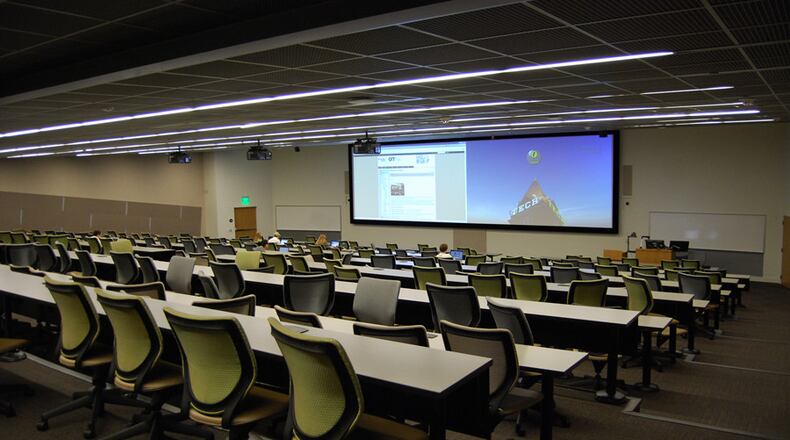Lauren Steimle is an assistant professor and Dima Nazzal is the director of professional practice in the H. Milton Stewart School of Industrial and Systems Engineering at Georgia Institute of Technology.
Working with an undergraduate and graduate student, they put social distancing plans by colleges to a test and find colleges are overly optimistic about their ability to create social distance in classrooms.
The project focused on space planning for higher education institutions to help with return-to-campus plans. With Natashia Boland, Steimle and Nazzal are co-leading a research team of undergraduate and graduate students in the H. Milton Stewart School of Industrial and Systems Engineering.
The code used to generate the socially distanced seating layouts was developed by Georgia Tech students Raneem Gashgari, Di Liu, Yuming Sun, Shimeng Zhang, and Yogesh Avhad, and is available on the group's Github page. The work was supported by the Thos and Clair Muller Research Endowment Fund.
By Lauren Steimle and Dima Nazzal
Classroom shortages are going to make it hard for colleges to deliver on a return to the classroom with social distancing.
We are told the whole point of returning to campus in the fall is to return to the classroom. But does a return to campus actually translate to a return to safe in-person instruction?
We found that colleges might be overly optimistic about how many students can actually fit in classrooms with social distancing. This means they might be headed for overcrowding in classrooms or shifting large amounts of instruction time online to avoid this.
Colleges recognize there is a trade-off between the valuable in-person instruction time and the risk of COVID-19 transmission in classrooms. The risk of transmission in classrooms is particularly high. A group of students sitting in a classroom for the hour or so is a perfect way for COVID-19 infections to be passed on.
Catching COVID-19 from an infectious person becomes much more likely the more time you spend with them, and an hour is plenty of time for this nasty bug to find a new host. (Experts deem 15 minutes as a cut-off time for keeping risk low.)
However, the stated purpose of bringing students back to campus is a return to meaningful discussions and activity in-person that could not be accomplished with online learning.
So what’s the cure for colleges? One answer might seem obvious: social distancing in classrooms. But this is where things get sticky. Every classroom on campus can now hold fewer students at a time. So how many students can fit in classrooms with social distancing?
The answer is shockingly low. Some schools are estimating 40-50% of capacity can be used, which is overly optimistic. Others have not yet determined these values.
In reality, we are seeing classroom capacity being reduced to 15%-30% of the room’s original capacity depending on the layout of the room and what precautions are taken.
To demonstrate, picture a large classroom with around 5,900 square feet that can normally hold 305 students. The seats and desks are fixed in place, in long rows facing the professor who is usually at the front of the room. How many students can this room seat if all had to be at least six feet apart?
Many people would estimate around 100 students, perhaps imagining that this way two empty seats could be left between every pair of students. But this is overly optimistic.
With an industrial engineering technique called mathematical optimization, we calculated the maximum number of students that could be seated in this room in a way that ensures all students are seated at least six feet apart. Without considering the risks for seats near high activity areas, such as aisles or doors, and the location of the professor, only 78 students can fit.
After restricting seats near high activity areas, just 60 students can fit in this room – a mere 20% of the room’s original capacity.
Considering this room would likely be one of the largest classrooms on a typical college campus, you can imagine how social distancing in hundreds of classrooms across a college campus would drastically reduce the number of students that can be in class at any given time.
If planners don’t recognize this beforehand, they might be unknowingly crowding students into high-risk classrooms. Even if they do recognize this, colleges may need to shift even more instruction time online than they had originally anticipated.
With classrooms filled to only 25% of seating capacity to ensure social distancing, a large number of classes will need to be delivered remotely or in a hybrid mode.
Further, if students are not required to wear masks, six feet might not be far enough for an indoor setting, and as such, students would need to be placed farther apart.
This translates into even less instruction time delivered in person. Schools are inevitably going to run into shortages of classrooms due to reduced classroom capacity and will be forced to move a large amount of instructional time online.
As colleges make their plans for returns to campus during the COVID-19 pandemic, administrators are facing many complex trade-offs. The details of the implementation plans are incredibly important to ensure that colleges are achieving their desired balance between the many factors that are coming into play with their return.
About the Author
The Latest
Featured





